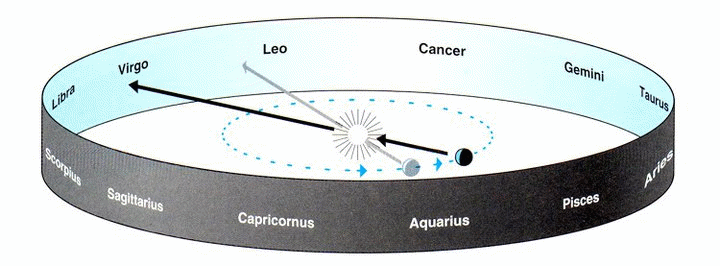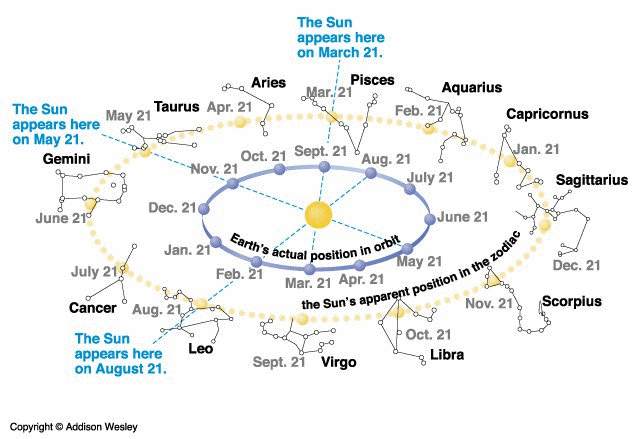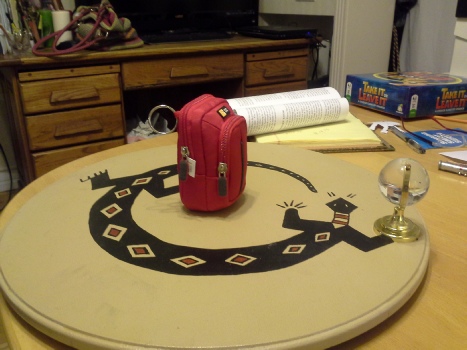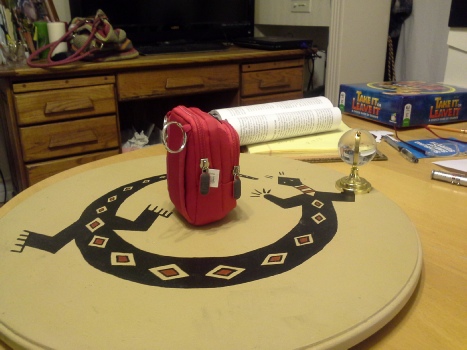

From time to time, I just want to understand what this is. I have to make a model in my mind to have it make sense, and, frankly, I end up making a physical model. I do this even to understand what an equinox is – I’m just forgetful, I think. But while I can do the equinoxes themselves all right, and see in my model how it is that the days get longer and the nights get shorter after the winter solstice, I’ve never really been able to visualize what’s going on with the famous precession of the equinoxes. And why is it called “precession” instead of “procession” anyway?
Maybe this time, I’ve got it. We’ll see.
The model is pictured below. The red camera bag is the Sun. The glass Earth globe is the Earth, and the Lazy Suzanne is a physical representation of the Earth’s orbit around the sun. Notice the axis of the Earth pointing up and off right.
It is important to realize that as the Lazy Suzanne (LS) turns, the axis remains pointing to the same spot on the celestial sphere. (The celestial sphere is modeled by the walls, ceiling and floor of my office in the picture.) I can imagine the glass globe as a gyroscope holding its point, but I have no way to model that physically. Note also that I keep the globe on the right front claw of the lizard on the LS in the pictures.
This is a panel. Close it by clicking somewhere not on it. May take two clicks.
May include gaphics and hyperlinks.

Given the direction of the Earth’s axis, the situation modeled on the LS marks one equinox point for Earth in its orbit.
for Earth in its orbit.
The view of the celestial sphere (the walls of the room) from Earth through the Sun at sunrise will give some definite set of stars at this equinox. (This is true all day long, not just at sunrise, of course. So the sun is “in” the same star set all day long.)
will give some definite set of stars at this equinox. (This is true all day long, not just at sunrise, of course. So the sun is “in” the same star set all day long.)
As long as the axis points to the same place in that celestial sphere (Polaris, perhaps) this equinox will always occur with the sun in that set of stars.
(As the year progresses and the LS turns, people see different star sets through the Sun at sunrise. They have divided this 360° circuit into 12 “signs of the Zodiac.” See below for very superior illustrations !)

Below are two wonderful illustrations that I’ve taken (permission requested) from a website called Nirmukta:


Here I have moved the Earth axis to point at a different place on the celestial sphere.
Notice that although the Earth remains at the same location on the Lazy Suzanne (its orbit around the Sun) we no longer have an equinox.
To get an equinox with this new axis direction, we’re going to have to move the LS while maintaining the new orientation of the Earth axis with respect to the celestial sphere.

This is the same equinox  with the new orientation.
with the new orientation.
Notice that now the view of the celestial sphere from Earth through the Sun at sunrise will give a quite different set of stars from what we had before. If the Sun was rising in Pisces before, now it’s rising in Aquarius on the morning of the vernal equinox. (See the Nirmukta illustrations.)
But does this ever happen? Not suddenly like this, but very gradually, yes.
The orientation of the Earth axis with regard to the plane of the Earth’s orbit around the Sun is called the obliquity of the pole. It varies from 22.1° to 24.5° over a cycle of 25,776 years.  The pole ends of the axis move in (relatively) small circles counter to the rotation of the Earth and to its orbit around the Sun. This movement results in a very slow and gradual change in which sign of the zodiac the Sun is seen to rise in from the Earth at the vernal equinox. This is the precession of the equinoxes, and it moves the equinox sunrise from the beginning of one sign to the beginning of the next in about 2160 years. We are currently in transition between Pisces and Aquarius.
The pole ends of the axis move in (relatively) small circles counter to the rotation of the Earth and to its orbit around the Sun. This movement results in a very slow and gradual change in which sign of the zodiac the Sun is seen to rise in from the Earth at the vernal equinox. This is the precession of the equinoxes, and it moves the equinox sunrise from the beginning of one sign to the beginning of the next in about 2160 years. We are currently in transition between Pisces and Aquarius.
Notice in the Nirmukta illustrations, that the normal movement of the Earth around the sun (counter clockwise as seen from above the northern hemisphere of the Earth) yields a normal procession of the constellations of the Zodiac through the night sky during a year from east to west, like the Sun and Moon.
But the result of the clockwise movement of the Earth axis in its near 26,000-year period is to move the Zodiac signs slowly in the other direction. I’m guessing this is why people have chosen the word “precession” to name this slow counter-movement of the Zodiac constellations from our Earth perspective over this very long period.


 for Earth in its orbit.
for Earth in its orbit. will give some definite set of stars at this equinox. (This is true all day long, not just at sunrise, of course. So the sun is “in” the same star set all day long.)
will give some definite set of stars at this equinox. (This is true all day long, not just at sunrise, of course. So the sun is “in” the same star set all day long.)


 with the new orientation.
with the new orientation. The pole ends of the axis move in (relatively) small circles counter to the rotation of the Earth and to its orbit around the Sun. This movement results in a very slow and gradual change in which sign of the zodiac the Sun is seen to rise in from the Earth at the vernal equinox. This is the precession of the equinoxes, and it moves the equinox sunrise from the beginning of one sign to the beginning of the next in about 2160 years. We are currently in transition between Pisces and Aquarius.
The pole ends of the axis move in (relatively) small circles counter to the rotation of the Earth and to its orbit around the Sun. This movement results in a very slow and gradual change in which sign of the zodiac the Sun is seen to rise in from the Earth at the vernal equinox. This is the precession of the equinoxes, and it moves the equinox sunrise from the beginning of one sign to the beginning of the next in about 2160 years. We are currently in transition between Pisces and Aquarius.


